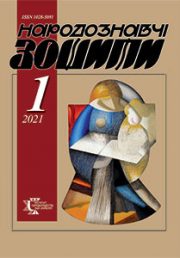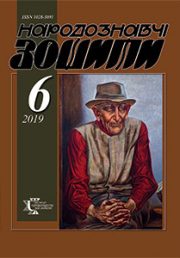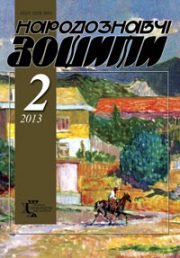The Ethnology Notebooks. 2020. № 4 (154), 797—805
UDK 746.3(477.83-21Городок)”20”
DOI https://doi.org/10.15407/nz2020.04.797
HORODOK AS THE CENTER OF FOLK EMBROIDERY: HISTORY, CURRENT STATE, DEVELOPMENT PROSPECTS
KUTSYR Tetiana
- ORCID ID: http://orcid.org/ 0000-0002-6522-0640
- candidate of arts studies (Ph. D),
- Researcher at Folk Art Department
- Ethnology Institute National Academy of Sciences of Ukraine,
- 15, Svobody ave, 79000, Lviv, Ukraine,
- Contacts: e-mail: sonechko_29@ukr.net
Abstract. The search for the visualization of national identity typical for the beginning of the XXI century has actualized the deepening study of Ukrainian folk art. In this context embroidery is of particular interest as an expressive and affordable way decoration garment.
Paper purpose — to clarify the artistic specific of Gorodok folk embroidery in the historical aspect, to study the main stitches inherent in this center, to analyze the principles of combining them into the united composition. The research object is the Horodok folk costume components, decorated with embroidery, and the subject — the compositional features of their decor. The research techniques of work are a comprehensive approach to the chosen object of study, art analysis in the study of the features Horodok embroidery, structural and comparative methods — to determine its originality. The works of Ukrainian and art studiers as well as archival sources, graphic and photographic materials together with Horodok folk clothing preserved in state and private collections were used as the source base.
Results. The study of the preserved artefacts revealed the specifics of the decoration of Horodok folk clothing with embroidery, which differed depending on the typological group of items and the wearer sex. For example, women`s shirts and kerchiefs were decorated by so-called «Horodok Stitch», which was based on combination of loop stitch with free fill stitch. For «bavnnytsia» (embroidered band used as a part of headwear) decoration was used «Bavnnytsia Stitch» — some kind of counted-thread fill stitch. In outerwear decor stitches of linear outlining are prevailed. There was backstitch, basting stitch, chain stitch, catch stitch etc. For each of the counted stitches their own composition as well as the place on the items were inherent. Each of these stitches had its own colour. In girls’ and women’s shirts and kerchiefs, the combination of red and white with small drops of blue or black prevailed. «Bavnytsias» were most often embroidered by red or blue threads. The most restrained in colour was the outerwear decor. In this case, most often used unbleached linen or black cotton threads.
Conclusion. Horodok embroidery is characterized by a significant variety of compositions and an individual approach to the decoration of different types of folk clothing. Differentiation principle, as well as expediency and artistic moderation, based on the comparison of filled with embroidery and clean planes can be successfully applied to modern clothing, giving it elegance and unique individuality.
Keywords: Opillia, Horodok, folk embroidery, «Horodok stitch», motif, composition, colouring.
Received 26.05.2020
REFERENCES
- Bilan, M.S., & Stelmashchuk, H.H. (2000). Ukrainian Clothing. Lviv: Fenix [in Ukrainian].
- Stelmashchuk, H.H. (2013). Ukrainian Folk Clothing. Lviv: Apriori [in Ukrainian].
- Kosmina, O. (2013). Traditional Clothing of Ukrainians. Forest-steppe-steppe (Vol. I). Kyiv: Baltia-druk [in Ukrainian].
- Kara-Vasylieva, T. (1993). Ukrainian Embroidery: Album. Kyiv: Mystetstvo [in Ukrainian].
- Selivachov, M. (2013). Lexicon of Ukrainian Ornamentation (Iconography, Nomination, Styles, Typology). Kyiv: Ant [in Ukrainian].
- Falkiewicz, K. (1896). Monograph of Horodok District. Grуdek: Grуdecka Rada powiatowa [in Polish].
- Hurhula, I. (1966). Folk Art of Western Regions of Ukraine. Kyiv: Mystetstvo [in Ukrainian].
- Hurhula, I., & Chekhovych, S. (1959). Folk Craftsmen. Lviv: Knyzhkovo-zhurnalne vydavnytstvo [in Ukrainian].
- Chekhovych, S. (Dateless). Embroiderers of Horodok district. Archive of the Manuskripts Department of the V. Stefanyk Lviv National Scientific Library. F. 140. № 15. Un. save 40+12 [in Ukrainian].
- Ivasiuta, M.K., & Kravchuk, L.T. (Eds.). (1961). Ukrainian Folk Embroideries. Lviv Region. Kyiv: Vydavnycztvo Akademiyi nauk Ukrayinskoyi RSR [in Ukrainian].
- Kulchytska, O. (2018). Folk Clothing of Western Regions of Ukraine (From Collection of Andrey Sheptytskyi National Museum in Lviv): Album-Catalog. Lviv: Andrey Sheptytskyi National Museum in Lviv [in Ukrainian].
- Embroidery samples of cuffs, collars, shoulders of women`s shirts. The end of the ХІХ — early the ХХ centuries. Exhibition «Ukrainian Folk Embroidery from Olena and Olha Kulchytska Collection». Andrey Sheptytskyi National Museum in Lviv (further — NML); Olena Kulchytska Art and Memorial Museum. 10/04/2018—01/20/2019.
- Mateiko, K. (1977). Ukrainian Folk Clothing. Kyiv: Naukova Dumka [in Ukrainian].
- Zakharchuk-Chuhai, R.V. (1988). Ukrainian Folk Embroidery. Western Regions of Ukr SSR. Kyiv: Naukova Dumka [in Ukrainian].
- Blachowski, Al. (2011). Attire and cultural landscape of Poland and Western Ukraine in the iconography of J. Glogowski and K.W. Kielisinski. Torun: Muzeum Etnografichne [in Polish].
- Photo library of the Ethnology Institute of the NAS of Ukraine. № 22677/13.
- Lviv Historycal Museum. № 1195. The end of the ХІХ century. Horodok.
- Museum of Ethnography and Crafts of EI of the NAS of Ukraine. EP-20472. The end of the ХІХ — the first half of the ХХ centuries. Kernytsia village, Horodok district, Lviv region.
- NML NMT-623. The beginning of the ХХ centuries. Hyshevychi village, Horodok district, Lviv region.
- Kalyniak, M. (2004). Ukrainian Embroidery. Modern Interpretation: Album. Lviv: Ukrainski Tekhnolohiii [in Ukrainian].







